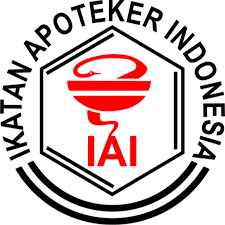Optimization of Ethanol Extract Preparation Gel Formula from the Combination of Lime Peel and Neem Leaves : Optimum Physical Properties and Antibacterial Activity
Andrea Yovva Rahmana(1), Setyo Nurwaini(2*)(1) Undergraduate Student, Faculty of Pharmacy, Universitas Muhammadiyah Surakarta, Jl. A. Yani 157 Pabelan, Kartasura, Sukoharjo, 57169, Indonesia
(2) Department of Pharmaceutics, Faculty of Pharmacy, Universitas Muhammadiyah Surakarta, Jl. A. Yani 157 Pabelan, Kartasura, Sukoharjo, 57169, Indonesia
(*) Corresponding Author
Abstract
Lime peel (Citrus aurantifolia) and neem leaf (Azadirachta indica) have antibacterial properties, especially against Staphylococcus aureus. These two ingredients can be used to treat various skin problems caused by Staphylococcus aureus. This study aimed to determine the optimal ratio of 96% ethanol extract of lime peel and neem leaves to produce a gel formula with optimum physical properties and antibacterial activity. Physical properties tested were pH test, adhesion test, spreadability test, and viscosity test. Antibacterial activity was measured by inhibition zone diameter when tested by the well method. There were 8 gel formula with the various ratio of components of lime peel and neem leaves extracts, FI (8:2), FII (6.5:3.5), FIII (5:5), FIV (3.5:6.5), FV (2:8). The optimization method used was Simplex Lattice Design using the Design Expert 11 application (Trial). The optimum formula obtained from the Design Expert was verified and analyzed using the SPSS one-sample t-test with a 95% confidence level. The optimum formula of lime peel and neem leaves obtained were 8.00%:2.00% with a desirability value of 0.471. The one sample t-test showed that the results were not significantly different between the predicted and verified values.
Keywords
Full Text:
PDFReferences
Babaei, A.H. et al. (2018) ‘In vitro study of antibacterial property and cytotoxic effects of aqueous, ethanolic, methanolic, and hydroalcoholic extracts of fenugreek seed’, Pakistan Journal of Medical and Health Sciences, 12(2), pp. 906–910.
Bayan, M.F., Chandrasekaran, B. and Alyami, M.H. (2023) ‘Development and Characterization of Econazole Topical Gel’, Gels, 9(12). Available at: https://doi.org/10.3390/gels9120929.
Cheung, G.Y.C., Bae, J.S. and Otto, M. (2021) ‘Pathogenicity and virulence of Staphylococcus aureus’, Virulence, 12(1), pp. 547–569. Available at: https://doi.org/10.1080/21505594.2021.1878688.
David, M.Z. and Daum, R.S. (2017) ‘Treatment of Staphylococcus aureus infections’, in Current Topics in Microbiology and Immunology. Springer Verlag, pp. 325–383. Available at: https://doi.org/10.1007/82_2017_42.
Ekawati, E.R., Pradana, M.S. and Darmanto, W.I.N. (2019) ‘Lime (Citrus aurantifolia) peel as natural antibacteria for wound skin infection caused by Staphylococcus aureus’, International Journal of Pharmaceutical Research, 11(1), pp. 363–366. Available at: https://doi.org/10.31838/ijpr/2019.11.01.042.
Del Giudice, P. (2020) ‘Skin infections caused by Staphylococcus aureus’, Acta Dermato-Venereologica, 100(100-year theme Cutaneous and genital infections), pp. 208–215. Available at: https://doi.org/10.2340/00015555-3466.
Hashim Yaseen, K. (2016) ‘Antibacterial activity of different part of Neem (Azadirachta indica) growing in Sharjah, United Arab Emirates’, Yaseen Iraqi Journal of Science, 57(4B), pp. 2617–2626.
Kuo, S.H. et al. (2020) ‘Role of pH value in clinically relevant diagnosis’, Diagnostics, 10(2), pp. 1–17. Available at: https://doi.org/10.3390/diagnostics10020107.
Marlina et al. (2023) ‘Antioxidant serum gel formulation with a combination of secretome from mesenchymal stem cells and rosemary oil’, IOP Conference Series: Earth and Environmental Science, 1228(1). Available at: https://doi.org/10.1088/1755-1315/1228/1/012036.
Mehrishi, P. et al. (2022) ‘Antibacterial and antibiofilm properties of Azadirachta indica (Neem), Aloe vera (Aloe vera), and Mentha piperita (Peppermint) against multidrug-resistant clinical isolates’, Biomedical and Biotechnology Research Journal, 6(1), pp. 98–104. Available at: https://doi.org/10.4103/bbrj.bbrj_178_21.
Mohiuddin, A.K. (2019) ‘Skin Care Creams: Formulation and Use Related papers’, Dermatology Clinics & Research, 5(1), pp. 238–27. Available at: www.scitcentral.com.
Pakan, P. et al. (2023) ‘Topical Antibacterial Therapy from Moringa oleifera Extract Against Staphylococcus epidermidis’, Tropical Journal of Natural Product Research, 7(10), pp. 4182–4185. Available at: https://doi.org/10.26538/tjnpr/v7i10.10.
Saeed, A., Shah, B.G. and Khan, F. (2019) ‘Anti-bacterial potential of Azadirachta indica extract against Staphylococcus aureus’, Pakistan Journal of Medical and Health Sciences, 13(3), pp. 959–961.
Safeena, M.I.S. (2019) ‘Effect of crude extract mixtures of five selected medicinal plant species on Malassezia sp.’, 9th International Symposium, (November), pp. 576–587. Available at: http://ir.lib.seu.ac.lk/handle/123456789/3941.
Santosaningsih, D. et al. (2018) ‘Prevalence and characterisation of Staphylococcus aureus causing community-acquired skin and soft tissue infections on Java and Bali, Indonesia’, Tropical Medicine and International Health, 23(1), pp. 34–44. Available at: https://doi.org/10.1111/tmi.13000.
Sekar, M. et al. (2015) ‘Comparative evaluation of antimicrobial properties of Citrus varieties available in Malaysia market’, International Journal of Current Pharmaceutical Research, 5(4), pp. 32–35.
Syarifah, A., Budiman, A. and Nazilah, S.A. (2021) ‘ Formulation and Antioxidant Activity of Serum Gel of Ethyl Acetate Fraction From Musa x paradisiaca L. ’, Proceedings of the 4th International Conference on Sustainable Innovation 2020–Health Science and Nursing (ICoSIHSN 2020), 33(ICoSIHSN 2020), pp. 310–315. Available at: https://doi.org/10.2991/ahsr.k.210115.066.
Tjahyadi, D. et al. (2015) ‘Organoleptic, pH Stability, Viscosity, and Sterility of Sonohysterosalpingography Hydroxy Propyl Cellulose-Based Gel (As an Alternative Media for Examination of Hystero-Foam Sonosalpingography)’, American Journal of Research Communication, 3(5), pp. 10–27.
Tong, S.Y.C. et al. (2015) ‘Staphylococcus aureus infections: Epidemiology, pathophysiology, clinical manifestations, and management’, Clinical Microbiology Reviews, 28(3), pp. 603–661. Available at: https://doi.org/10.1128/CMR.00134-14.
Wagoner, T.B. et al. (2020) ‘Viscosity drives texture perception of protein beverages more than hydrocolloid type’, Journal of Texture Studies, 51(1), pp. 78–91. Available at: https://doi.org/10.1111/jtxs.12471.
Wardani, R., Jekti, D.S.D. and Sedijani, P. (2018) ‘Uji Aktivitas Antibakteri Ekstrak Kulit Buah Jeruk Nipis (Citrus aurantifolia Swingle) terhadap Pertumbuhan Bakteri Isolat Klinis’, Jurnal Penelitian Pendidikan IPA, 5(1). Available at: https://doi.org/10.29303/jppipa.v5i1.101.
Zhang, J. and Zhou, L. (2018) ‘Preparation and optimization of optical pH sensor based on sol-gel’, Sensors (Switzerland), 18(10). Available at: https://doi.org/10.3390/s18103195.
Article Metrics
Abstract view(s): 260 time(s)PDF: 238 time(s)
Refbacks
- There are currently no refbacks.








